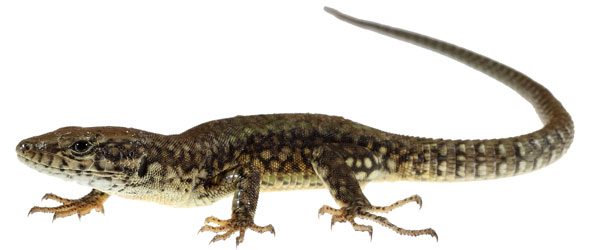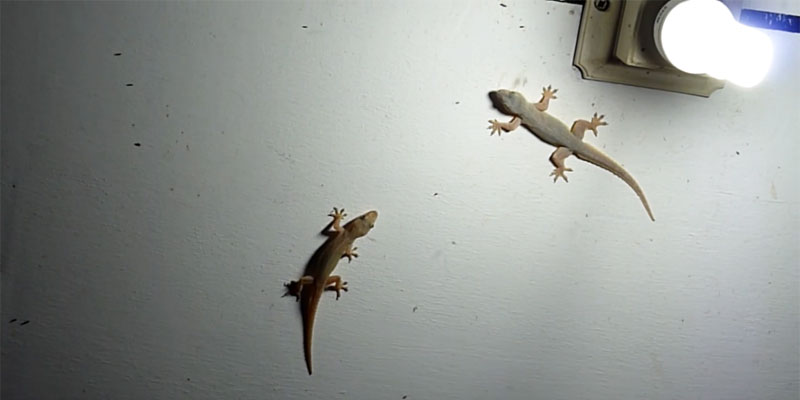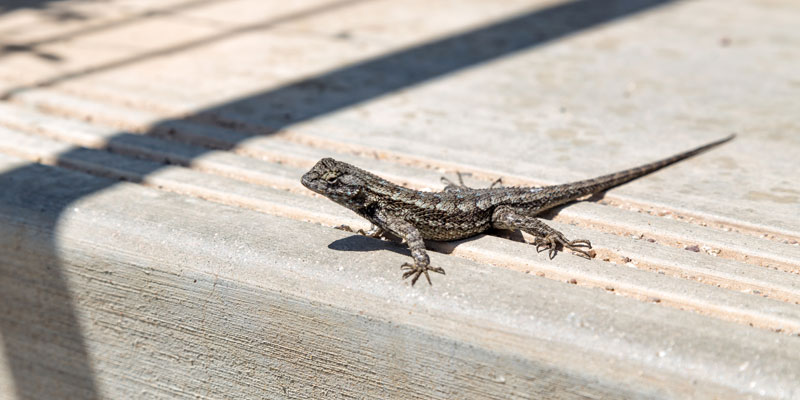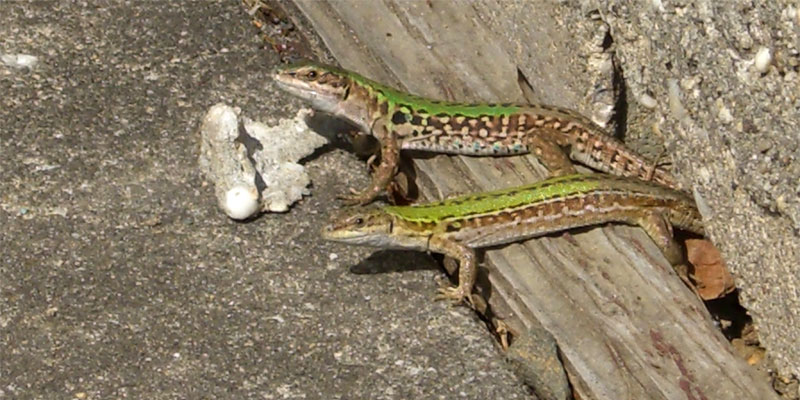How To Keep The Damn Deer Away From My Garden
Disclosure: This post may contain affiliate links. This means that at no cost to you, we may earn a small commission for qualifying purchases.
Do you remember the days when T-Rex was king of the dinosaurs and thought to be giant, scaly reptiles? This imagery may no longer be realistic, but you'd still probably scream like one was chasing you if a lizard ran across your living room floor.
Here's how to get rid of them so you can make sure your property never turns into Jurassic House.
Want to Let the Pros Handle It?
Get a free quote from top pest control companies in your area.
Getting to Know Lizards
The term lizard applies differently in scientific and layman terminology. Scientifically, a lizard has scaly skin, external ears, and most (but not all) have four legs. Sizes range from less than a foot long to the giant Komodo dragon. Not all reptiles are considered lizards, despite some having a strong resemblance.

Layman's terms are somewhat different, with the word lizard being applied to any creature that has a long body, four legs, and scaly skin. Thus, slowworms and other legless species are considered lizards in scientific terms, but not by the average person.
Did You Know:
There has been some debate about renaming dinosaurs. The name means "terrible lizard", but we now know that most dinosaurs were actually related to birds and even the T-Rex had developed feathers in some places.
Are Lizards Dangerous?
Unless you are counting amphibians as lizards, only one species is actually dangerous to humans: the Komodo dragon. These giant lizards have been known to attack and even kill humans. Crocodiles and alligators are actually reptiles and not scientifically considered to be lizard species.
Keep in mind, however, that lizard droppings may contain diseases the pooper has come across. As they eat mosquitoes and similar blood-feeding species, this could include a variety of nasty illnesses. Always be hygienic when clearing up any discovered lizard poop.
Lizard Benefits
As unpopular as lizards are, you might want to think twice about removing them from an outdoor habitat. These critters are insectivores and love munching on a wide variety of garden pests including ants, spiders, flies, potato bugs, crickets, springtails, and grasshoppers .
They're not harmful to you or your pets, and can save a lot of extermination headaches when you have a garden.
Many species, such as the gecko and chameleon, make great pets although it's never a good idea to capture one and try to turn it into a pet. These species are often regulated, and a lizard from the wild may carry diseases in their droppings that could be harmful.
Why You Shouldn't Kill a Lizard
As tempting as the thought may be, many species of lizard are protected and killing them may be illegal in your area.
Even if you identify the offending critter, using a lizard killing spray such as Raid Max or other lethal means can harm other critters, sometimes even your two or four legged family members.
How to Get Rid of Lizards
Getting rid of invading lizards isn't as difficult as it first might seem. For example, a squirt of cold water can slow them down, and they're known to literally walk into traps with only minor encouragement. Best of all, getting rid of a lizard can also mean getting rid of many other pests, so it really can be a win-win situation.
In the House

The easiest way to evict lizards from your home is to remove their sources of food and water. This means ensuring your house is clean and free of garbage or food debris.
Check for any leaky taps or other potential water sources. You will also need to find any potential entry points (such as cracks in the window, tears in your screens, or gaps between pipes and the outside walls) and seal them.
Most importantly, you'll need to get rid of any insect infestations. This is the main source of food, and without food, a lizard won't want to stick around.
A bug zapper can provide tasty bait to catch lizards in live traps, but make sure the design is solid and not a cage, as they can slip through very small spaces especially species as small as a skink or salamander. This Catcha model or something similar would work well.
Creating minimal hiding spaces can be a great way to make lizards feel less comfortable. Since they love to climb walls, this includes reducing the number of pictures hanging on the wall and making sure all furniture is at least six inches from the wall.
A more enjoyable remedy involves a pet such as cats, ferrets, or even skunks. These cuddly critters are known to hunt smaller lizards for fun or food. Of these, cats are the most successful, although they will often bring you their trophies. Skunks and ferrets love to snack on insects, making them a great pest control option in general.
See Also: Can Mice Climb Walls?
On the Porch

Want to Let the Pros Handle It?
Get a free quote from top pest control companies in your area.
You can not only keep lizards away, but also improve the efficiency of your home by keeping shrubs pruned away from the front door and any HVAC equipment. Having clearance means a lizard may not take the chance crossing that empty space to get to the door, and insects are less likely to congregate near the porch if there are no plants to hide in.
Avoid placing succulents on the porch, as lizards have been known to chew on these when no other water source is readily available. You can also sprinkle a little cayenne pepper around the edges of the porch. A large number of critters from insects to raccoons will find this to be a terrible irritant if they step in it, deterring lizards and their prey from coming too close.
In the Yard

Water, night light, and cover are the three cornerstones of attracting an all-you-can-eat buffet for lizards. Stick to sodium vapor or yellow lights at night, if any, to avoid attracting moths and other insects.
Remove any standing water to eliminate insect breeding grounds. Also, keep your lawn and shrubs trimmed to reduce cover. Again, avoid the use of succulents to minimize your yard's ratings on LizardHotels.com.
In the Garden
Getting lizards out of your garden is a lot tougher than simply removing them from the lawn. This is because your vegetables and flowers attract their main source of food – insects. At the same time, you don't want to destroy your own garden just to get rid of critters that aid it.
The easiest way to get rid of a lizard population is to let the cat at them. These lovable critters love hunting lizards and can eliminate an infestation quickly. You can also use a cayenne pepper mixture around the perimeter of your garden, but make sure you respray every few days.
In the Garage or Shed
The same techniques can be used for the garage as in the home, but can be more difficult to pest-proof this room (or building, if detached). Thankfully, these spaces can be treated with chemicals in the event they're not commonly accessed by your family as a living space.
Raid can be one of your best options here, and will also kill a variety of other pests. Lining the edges of the garage with a repellent spray such as Lizard Defense can help keep them out once you've eliminated any unwanted residents. After all, the only time you should ever have to deal with a gecko hanging out in your garage is if you switch your car insurance.
How to Catch a Lizard
Catching a lizard isn't as tough as it may first seem. When indoors, a simple cardboard box is often enough. Corner the lizard and use a broom or other object to nudge it towards the open box. They will almost always run in, thinking it's shelter. You can then tip the box upside down, slide another piece of cardboard under it, and escort your little visitor somewhere else.
You can also use a plastic no-kill trap for small lizards. These rodent traps (like this one) have one-way doors and very small openings, so your intruder won't get back out. Place some freshly killed bugs in there or use insect pheromones. The lizard will get trapped in the same way as a mouse or similar rodent and you can transport the catch to a safe release location.
How to Keep Lizards Away
Unfortunately, the market isn't as open to lizard control as it is to rodents or insects. You're not likely to find a natural lizard repellent spray at the local hardware store, but there are some everyday household items that can deter a hungry lizard. The following are just a few examples.
Repellents
Garlic
The best repellents will always be the most natural ones. Garlic, for example, is one of our favorites, and it works on lizards as well as a wide range of other pests (and is good for you, too!). You can place individual cloves in places lizards seem to hang out (be careful around household critters, as garlic is poisonous to cats and some other pets).
You can also make an effective spray using garlic, onion juice, and water that can repel a wide range of pests.
Related: Garlic – It Fights More Than Vampires
Cayenne Pepper
Cayenne pepper is another popular repellent spray. Simply mix hot sauce or crushed red pepper to water and spray it in places the lizards like to go. While harmless, the residue will irritate the feet on a wide range of pests, encouraging them not to come back.
Both sprays are excellent for home and garden applications. Just make sure to respray every couple days when using outdoors, as dew and rain can wash them away.
Commercial Repellents
Of course commercial repellents are also available. Even the best lizard repellents can be hit or miss but this one seems to be the most consistent at keeping lizards and geckos away.
Using Decoys
The effectiveness of using a decoy against any pest is still debatable, but well worth trying out. Unlike larger critters, you can skip having ceramic predators littered around the property in favor of more suggestive evidence. There are quite a few potential remedies, although some are more popular than others.
Want to Let the Pros Handle It?
Get a free quote from top pest control companies in your area.
Egg shells are one popular example. Scatter some broken egg shells around potential entry points and the lizard will think a predator is nearby. Remember, lizards tend to be egg layers, so seeing egg debris can be scary to them.
The same thing can be said for decorating with peacock feathers. Peacocks are a natural enemy of lizards and seeing potential traces of one will send a lizard running the other way.
How To Keep The Damn Deer Away From My Garden
Source: https://www.ridmycritters.com/how-to-get-rid-of-lizards/
Posted by: madisonwidefirearm.blogspot.com

0 Response to "How To Keep The Damn Deer Away From My Garden"
Post a Comment